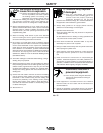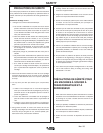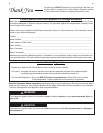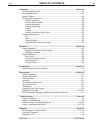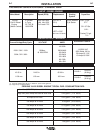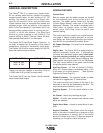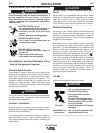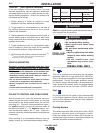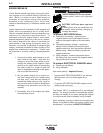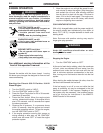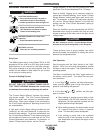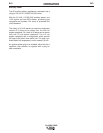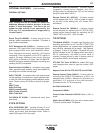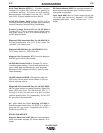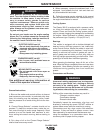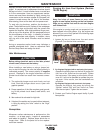
A-5
INSTALLATION
CLASSIC 300D
A-5
Battery Charging
The Classic 300 D is equipped with a wet charged
battery. The charging current is automatically regulat-
ed when the battery is low (after starting the engine)
to a trickle current when the battery is fully charged.
When replacing, jumping or otherwise connecting the
battery to the battery cables, the proper polarity must
be observed. This system is NEGATIVE GROUND.
GASES FROM BATTERY can explode.
• Keep sparks, flame and cigarettes
away.
BATTERY ACID can burn eyes and
skin.
• Wear gloves and eye protection and
be careful when boosting, charging or
working near battery.
To prevent EXPLOSION when:
a) Installing a new battery - disconnect the
negative cable from the old battery first and
connect the negative cable to the new battery
last.
b) Connecting a battery charger - remove the
battery from the welder by disconnecting the
negative cable first, then the positive cable and
battery clamp. When reinstalling, connect the
negative cable last.
c) Using a booster - connect the positive lead to
the battery first, then connect the negative lead to
the ground lead on the base.
To prevent ELECTRICAL DAMAGE when:
a) Installing a new battery.
b) Using a booster.
Use correct polarity - Negative Ground.
To prevent BATTERY DISCHARGE, if you have an
ignition switch, turn it off when engine is not
running.
• To prevent BATTERY BUCKLING, tighten nuts on
battery clamp until snug.
------------------------------------------------------------------------
WARNING
ENGINE BREAK-IN
Lincoln Electric selects high quality, heavy-duty indus-
trial engines for the portable welding machines we
offer. While it is normal to see a small amount of
crankcase oil consumption during initial operation,
excessive oil use, wetstacking (oil or tar like sub-
stance at the exhaust port), or excessive smoke is not
normal.
Larger machines with a capacity of 350 amperes and
higher, which are operated at low or no-load condi-
tions for extended periods of time are especially sus-
ceptible to the conditions described above. To
accomplish successful engine break-in, most diesel-
powered equipment needs only to be run at a reason-
ably heavy load within the rating of the welder for
some period of time during the engine’s early life.
However, if the welder is subjected to extensive light
loading, occasional moderate to heavy loading of the
engine may sometimes be necessary. Caution must
be observed in correctly loading a diesel/generator
unit.
1. Connect the welder output studs to a suit-
able resistive load bank. Note that any
attempt to short the output studs by con-
necting the welding leads together, direct
shorting of the output studs, or connecting
the output leads to a length of steel will
result in catastrophic damage to the gener-
ator and voids the warranty.
2. Set the welder controls for an output cur-
rent and voltage within the welder rating
and duty cycle. Note that any attempt to
exceed the welder rating or duty cycle for
any period of time will result in catastrophic
damage to the generator and voids the
warranty.
3. Periodically shut off the engine and check
the crankcase oil level.



